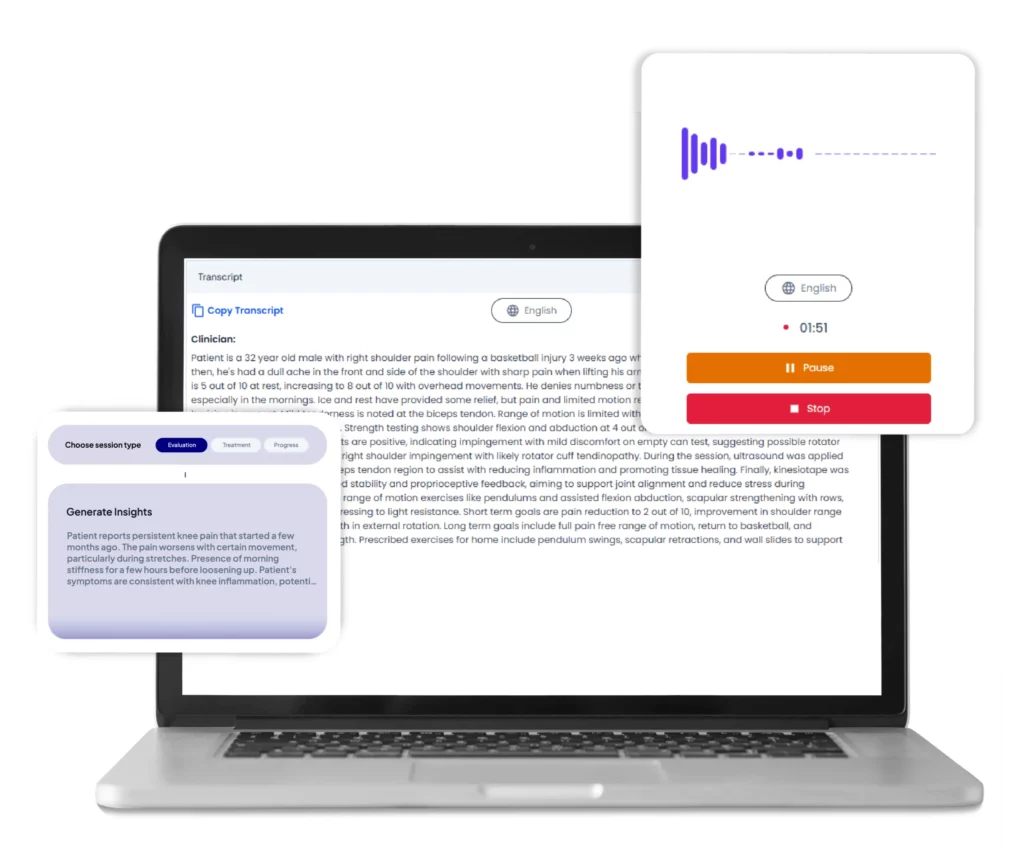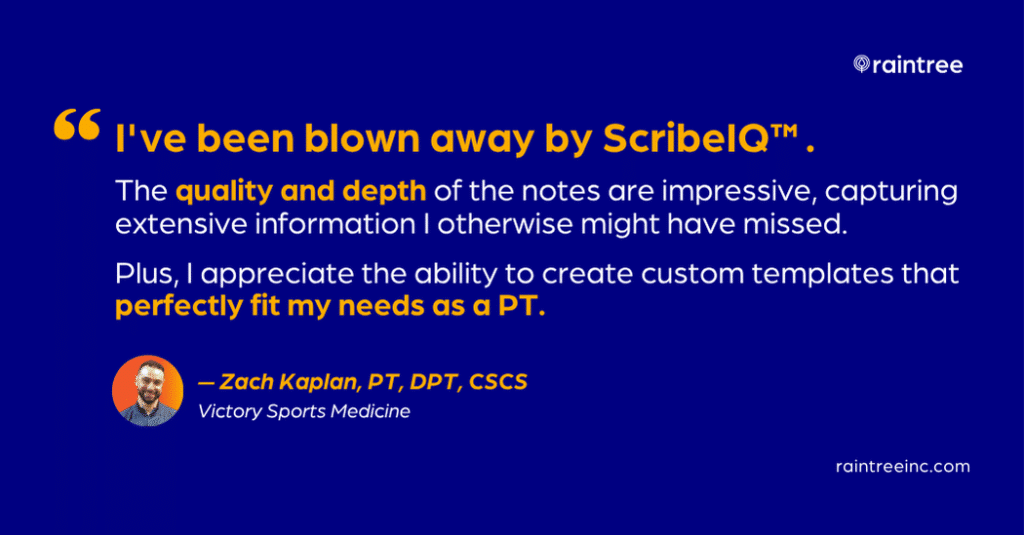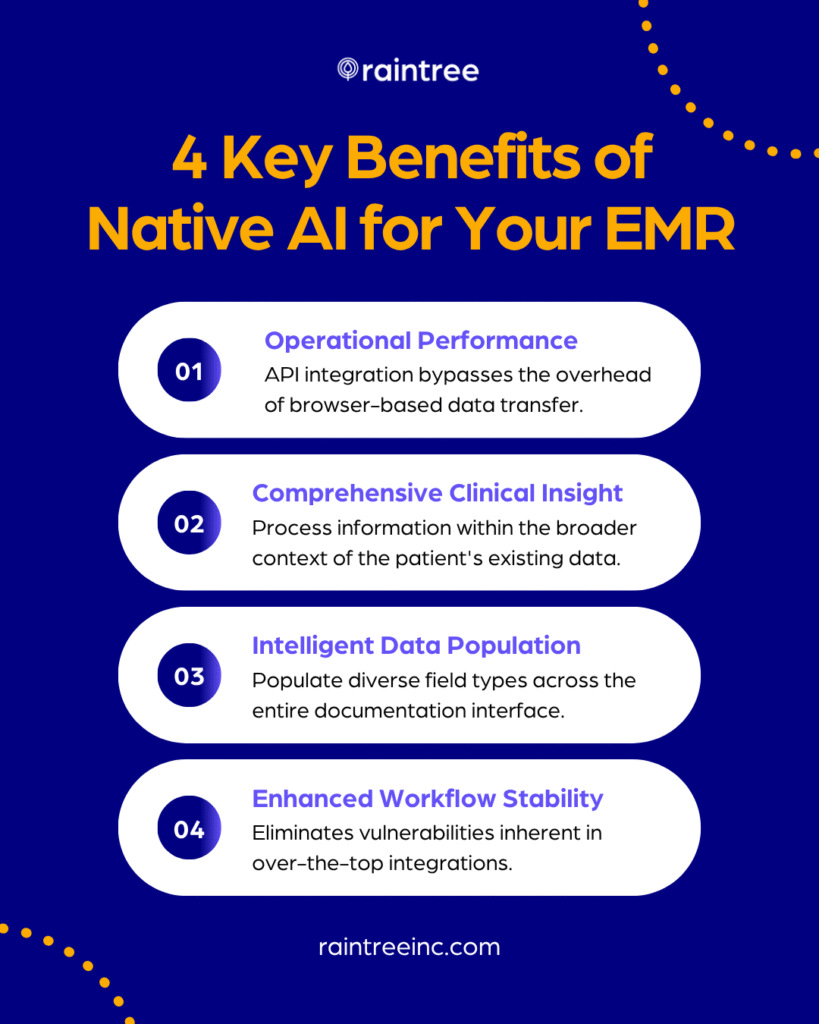Most rehabilitation and physical therapy organizations are exploring (or have already adopted) artificial intelligence in some capacity.
As Raintree’s Director of AI Product, I’m frequently in conversation with the clinical and operational leaders tasked with vetting these AI solutions. Along with the excitement of exploring new possibilities, our discussions often include a crucial question:
How should practices think about native AI solutions vs. third-party integrations? At the end of the day, is there really a meaningful difference in performance?
The short answer is, “Absolutely.”
Even if the technology performs similar functions, the value and benefits inherent in EMR-native AI solutions consistently outperform third party integrations.
Understanding the Landscape: Defining Native AI
What is Native AI?
A native AI integration means the AI solution is built directly into the core software platform. It leverages deep application programming interface (API) access, allowing for seamless communication and data exchange within the system’s architecture. In healthcare applications like EMRs, this means the AI becomes an inherent part of the platform rather than an external add-on.
What is Third-Party (Over-the-Top) AI Integration?
Third-party integrations typically sit on top of existing systems. These often rely on browser extensions or surface-level APIs to interact with the EMR. While they may offer the benefit of a quick entry point into AI, their capabilities are often limited by the constraints of these less-integrated approaches.
Why Native AI Outperforms Third-Party Solutions
The differences between AI native and third-party integrations manifest in several critical areas, directly impacting the solution’s effectiveness and reliability.
Better Performance and Expansive Possibilities
The true power of AI within an EMR lies in its ability to deeply interact with the system. When an AI solution has comprehensive access to the EMR’s data structure and field types, the possibilities for intelligent automation are expansive.
In the case of an AI scribe such as ScribeIQ™, unmatched depth of integration enables native AI to:
- Understand Context: Process information within the broader context of the patient’s existing EMR data, such as the overall patient case.
- Select Appropriate Fields: Intelligently populate diverse field types across the entire documentation interface, rather than just populating generic text areas.
- Apply Clinical Logic: Incorporate nuanced clinical rules and formatting, ensuring data is captured accurately and appropriately within the EMR’s existing framework.
- Stronger Accuracy: Direct API access allows the system to pull and analyze previous documentation, creating more accurate and contextually relevant current notes. This significantly reduces the potential for redundant or inconsistent information.
Beyond simply populating fields, a truly intelligent AI needs to understand the patient’s complete clinical picture.
Significantly Faster Processing
Speed is paramount in a busy clinical environment. Native AI solutions offer a distinct advantage here, too.
- Eliminating Overhead: Direct API integration bypasses the overhead of browser-based data transfer, leading to significantly faster note completion.
- Real-time Performance: Surface-level integrations can be extremely slow, especially when they need to account for existing data within the note (most cannot do this effectively). Native solutions, with their direct access, process information much more efficiently.

For therapy organizations and networks that operate hundreds or thousands of clinics—like many who make the switch to Raintree’s enterprise-grade EMR—efficiency stands out as a major advantage.
Eliminating Overlay Integration Failures
One of the most significant drawbacks of over-the-top integrations is their reliance on indirect access mechanisms, such as browser extensions screen scraping, or UI automation. These are prone to:
- Compatibility Issues: Browser updates or changes in the EMR’s web interface can easily disrupt the integration, leading to unexpected errors or downtime.
- Pop-ups and Interface Conflicts: Over-the-top solutions can often introduce disruptive pop-ups and interface conflicts that interrupt clinical workflows and create a frustrating user experience.
- Incorrect Data Population: The fragility of these integrations can result in information being populated into the wrong fields, or not at all, compromising data accuracy and patient safety.
In contrast, native integrations eliminate these vulnerabilities, providing a stable and consistent experience.
The First Native AI Solution Built for Physical Therapy and Rehabilitation
I led the team that developed ScribeIQ™, a native AI scribe solution within Raintree’s EMR platform. ScribeIQ™ embodies all the advantages of native AI, designed to enhance your clinical workflows and improve documentation accuracy with unparalleled reliability and intelligence.
The feedback from early adopters has been amazing.
Here are just a few of the reasons our AI scribe for therapy outperforms the rest:
AI Trained on Raintree
ScribeIQ™’s AI is specifically trained on Raintree’s complete note. This deep understanding means it comprehends every note page, field type, and data structure throughout the system. This allows ScribeIQ™ to be precisely configured for each client, adapting to unique workflows and rules.
EMR-Specific Best Practices Integration
ScribeIQ™’s AI insights are mapped using both general clinical knowledge and Raintree platform-specific workflows and documentation standards. This unique capability enables even new onboarding clinicians to adhere to best practices and deliver consistent, high-quality documentation.
Contextual Understanding and Intelligent Field Population
The combination of ScribeIQ™’s EMR-specific training and advanced noise suppression allows the AI to effectively determine what information is relevant to include, and to populate it into the system with the greatest level of accuracy.

The Clear Advantage of Native AI
By understanding the critical differences between native and third-party AI integrations, healthcare organizations can make informed decisions that lead to more robust, efficient, and clinically valuable AI deployments.
Ultimately, the goal of AI in healthcare is to enhance efficiency, improve accuracy, and support better patient care. To achieve this, your AI solution needs to be an integral part of your clinical ecosystem, not an add-on. Embracing native AI means investing in a future where technology truly empowers your clinicians, leading to more streamlined workflows and consistently higher quality documentation.

About the Author
Ben Catania is the Director of AI Product at Raintree, bringing extensive expertise in AI and software engineering to healthcare applications. He co-founded Yoomi Health, an AI rehabilitation therapy technology company acquired by Raintree, and previously led advertising performance initiatives at Meta. With a background in information science and economics from Cornell University, Ben has dedicated his career to bridging the gap between cutting-edge artificial intelligence capabilities and practical clinical applications that enhance patient care and streamline provider workflows.


